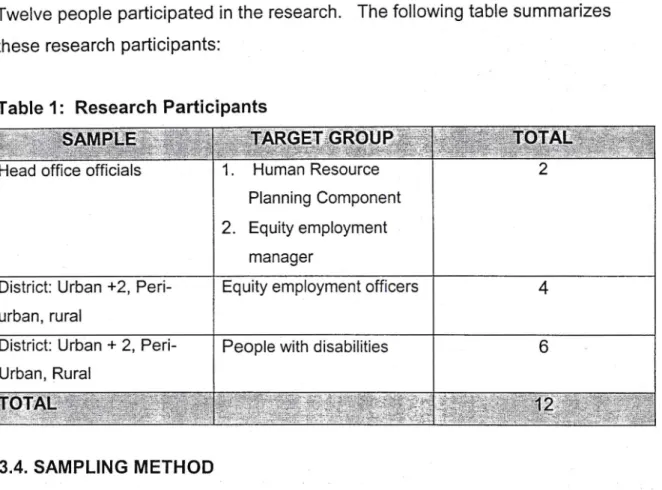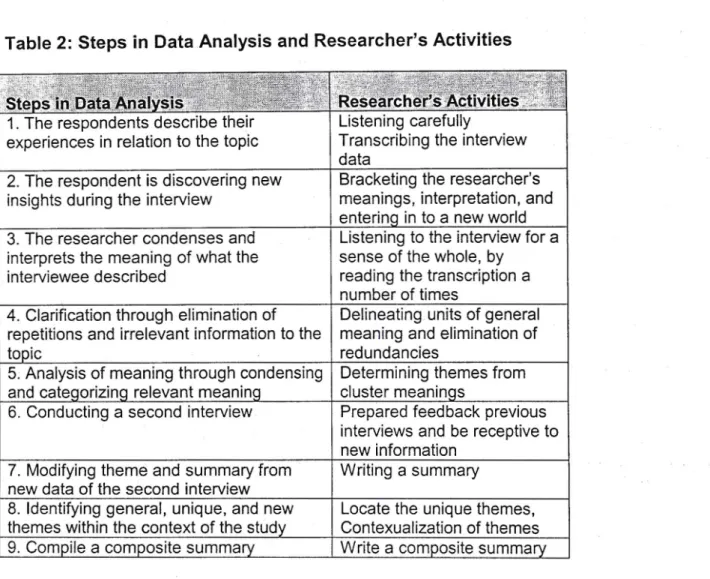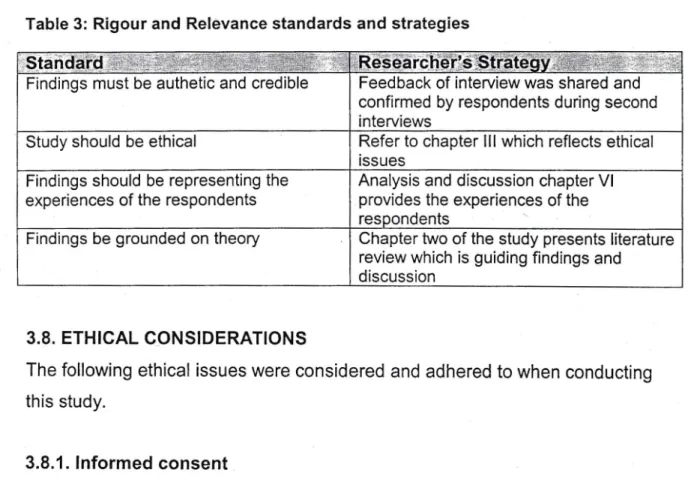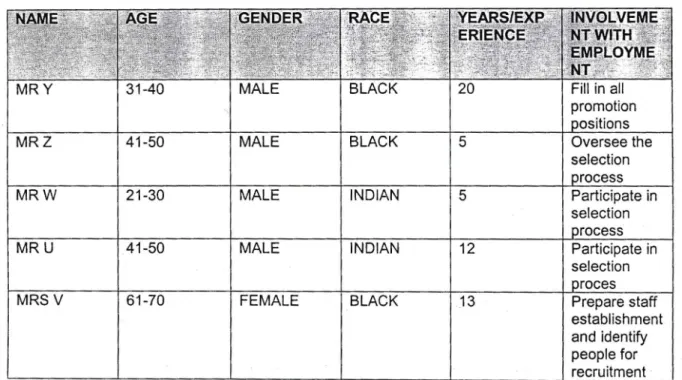Among the disabled, there is also a lack of awareness about the understanding of legal rights in the sense of the law. This will help ensure equal participation and acceptance of the process by disabled people and employment equality officers.
RATIONALE FOR THE STUDY
They are grouped into the core business and organizational issues to support the core business. The mandate of the Provincial Interdepartmental Disability Forum is to implement recommendations of the White Paper on Integrated National Disability Strategy (INDS).
PURPOSE OF THE STUDY The purpose of the study was
For example, the Mpumalanga province has a population of 211913 and a PWD workforce representation of 0.56% (refer to Annexure 11).
OBJECTIVES OF THE STUDY The objectives of the study were
THEORETICAL FRAMEWORK
VALUE OF THE STUDY
PRESENTATION OF THE CONTENTS
INTRODUCTION
DEFINITION OF DISABILITY
Long-term or recurring
A physical impairment is a partial or total loss of a bodily function or part of the body. Convention no. 111 of the International Labor Organization (ILO) deals with discrimination in employment and work.
SOUTH AFRICAN STATUS ON DISABILITY
It is estimated that 99% of disabled people are excluded from employment in the open labor market (White Paper on Integrated National Disability Strategy, 1997). Disabled Persons in the Office of the President and Disability Offices in all provinces in the Prime Minister's Office.
IMPLICATIONS OF DISABILTY FOR AN INDIVIDUAL IN THE WORKPLACE
Medical approach
The cornerstone of the medical approach is the medicalization of disability, that is, looking at disability as an individual pathology. The medical approach tends to reduce the problems of disabled people to their personal inadequacies or functional limitations.
Social approach
- Empowerment
- Integration
This can be linked to the liberal perspective of (Noon and Blyton, 1997) as it emphasizes that equal opportunity exists when all individuals are freely and equally enabled to compete for social rewards. It can be further linked to the radical perspective, which indicates that policymakers should be concerned with the outcome rather than the process and try to ensure a fair distribution of rewards. It also requires direct intervention through affirmative action policies, for example the Employment Equity Act. Werner (in O'Toole and McConkey, 1995) states that the goal of rehabilitation is to break down the walls of inequality, to work towards a social order that offers all people equal respect, opportunities and rights.
POLICY FRAMEWORK AND DISABILITY PROCESS ·
Role of SocialWork Practitioners in Policy Analysis and Implementation
Promoting values prescribed in the professional code of social workers. Promote the well-being of customers, consumers and citizens by shaping the human service system. Creating effective opposition against groups and citizens who do not subscribe to the ethics in the social workers code of practice.
Social workers have access to corridors of power and this gives them political power.Gray (1996) argues that social workers provide services to the most disadvantaged sectors of society. This positioning allows them to monitor the effectiveness of the implemented policy. Thus, social workers should play a visible and meaningful role in advocating for the implementation of the Employment Equity Act and other related legislation.
POLICY FRAMEWORK IN SOUTH AFRICA
Target System
- People with Disabilities
According to Chapter I of the Act, designated groups are black people, women and people with disabilities. The Employment Equality Commission developed a draft Code of Good Practice on Key Aspects of Disability on 19 April 2001 which was released to the public for comment. Its purpose is to guide employers in their implementation plan to follow the process more quickly. The Commission's Annual Report 2001 reveals that KwaZulu Natal has the highest population of people with disabilities.
It is one of the national policies aimed at promoting equality and anti-discrimination, especially in the workplace. The Act will help previously disadvantaged groups to achieve maximum productivity and efficiency (Employment Equality Commission Report. It is an internationally recognized policy and good for the country's sustainable economic and social development.
It provides an overview of the role of government and social workers in policy development. Employment Equity Act No. 55 of 1998, the values, guiding principles, key provisions, target system and strengths of this policy.
INTRODUCTION
RESEARCH DESIGN
THE RESEARCH PARTICIPANTS
SAMPLING METHOD
In this study, the researcher wanted to understand perceptions and experiences about people with disabilities in the workplace. A total of 12 participants were interviewed. The interviewees were the key participants and by virtue of their positions within the Department they were able to provide relevant information. In an attempt to gain an exploratory understanding of experiences and perceptions of key staff and people with disabilities around EER implementation, three methods of data collection were used viz.
According to Robson a self-completion questionnaire is based on a fixed sequence of mostly closed questions. It is used to collect personal data of respondents such as name, gender, race, age, language, occupation, years in current position and theirs. involvement in the recruitment process. The researcher used face-to-face in-depth interviews to gain an understanding and insight into key personnel's experiences and perceptions of the ZEE. The researcher used semi-structured interview schedules (Appendix V and VI), which were guided by open-ended questions.
For disabled people with disabilities, the focus was on the knowledge and perception of disabled people in the workplace, the recruitment process and how colleagues treated them. This report was quantitative in nature and content analysis by the researcher provided some qualitative input to the statistical data in the paper.
DATA ANALYSIS
RIGOUR AND RELEVANCE
ETHICAL CONSIDERATIONS
The findings of the study will be shared and used positively by those who participated in the study. Some of the respondents were emotional about their disabilities and the limitations in the workplace related to their disability. She was able to provide advice to respondents who were emotional and provided a supportive environment as she proceeded with the interviews without becoming emotionally involved. Pincus and Minahan (1983) point out that in order for the social worker to use relationships consciously, he or she must be aware of his or her own emotions, attachments, and preferences and try to keep them from interfering with the work of his/her
LIMITATIONS OF THE STUDY
A limitation of the study concerns the data recording, a recorder was not used due to the unavailability of this equipment. The researcher relied on handwritten data and therefore may have missed capturing some information. The researcher then compiled and returned the interview summary and themes to the respondents and then conducted the second interview.
According to Creswell, internal validity refers to the accuracy of information and whether it matches reality.
CONCLUSION
State of implementation of the Act on Equality in Employment in the Regional Office, Human Resources Planning component. The Department produced a job profile in the form of an EE Gap Analysis Report, June 2001, and some policies were reviewed. In this report, gaps in EEA implementation were analyzed at each employment level or institution category.
This report was used as a basis for analyzing the results obtained during data collection. In this area, the researcher had to explain the key provisions of the code to the interlocutors. The findings show that only the headquarters of the Ministry of Health had access to a copy of the Employment Equality Plan.
The findings also show that more emphasis has been placed on the implementation of the Skills Development Act (USA). Most of the respondents were familiar with the law, only 2 out of 6 did not know at all. Only two of the four workers mentioned were employed after the EEA was declared.
It is important that the employer is aware of the employee's disability in order to provide him with the necessary accommodation.

INTRODUCTION
CONTEXT
PURPOSE AND OBJECTIVES OF THE STUDY
To explore people with disabilities' workplace perceptions and experiences of EEA implementation. The results reveal that PWD in the Ministry of Health .. have knowledge and understanding of the law, although this level of .. knowledge is not satisfactory in light of the pace at which the EEA should be implemented. ~ believed that the research has raised awareness among key staff and PWDs in relation to the EEA .. have an acceptable level of knowledge with respect to the Act's reasonable accommodation clause. ~ are aware of general skills development processes, even if this process did not address the specific needs of disabled people .. lacks forum to learn, share and raise specific concerns of people with disabilities .. gt;- have good and supportive relationships with colleagues. Failure of HR practitioners to contextualise key provisions of the Employment Equity Act No 55 of 1998.
Inability to translate the demands of the law into action Le.developing an Employment Equity Plan. Inadequate training in EEA implementation.. gt; Ineffective EEA monitoring procedures at district and institutional levels .. gt; Ineffective EEA reporting [district and institutional level procedures. Only the headquarters constituted this committee and it is expected to provide technical and practical expertise to districts and institutions. );> lack of knowledge about disabilities and issues related to this sector.
RECOMMENDATIONS
It is recommended that programs for the empowerment of persons with disabilities be implemented in and outside the workplace. Implement community programs that educate communities about the Employment Equity Act and other human rights legislation. Promote a culture of inclusion of people with disabilities in the community as a means of preventing discrimination against people with disabilities in communities and in the workplace.
In addition, it is recommended that social work students at tertiary level are made aware of the needs of people with disabilities. Employment Equity Act No. 55 of 1998 and the Code of Good Practice on Key Disability Aspects are key documents that provide a framework for correcting the imbalances of the past and eliminating unfair discrimination in the workplace. Only when everyone is fully engaged in this course will people with disabilities be able to take their rightful place in the open labor market.
South African Government Online (2001) Employment Equity Statistical Workplace Profile Report.http://www.labour.gov.za/docs/leg islation/eea/index.asp. The Draft Code of Good Practice on Key Aspects of Disability in the Workplace (2001) http://www.labour.gov.za/docs/legislation/ea/codegoodpractice.htm.
REPRESENTATION OF PEOPLE WITH DISABILITIES PER PROVINCE'
I AFRIKAANS
QUESTIONNAIRE
Your own feelings about the Act (reasons) Your own experiences (Implementation) Challenging aspects of the Act.



